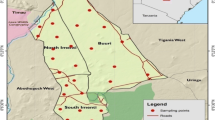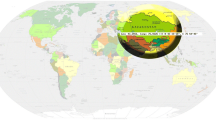Abstract
The aim of this work was to report on imidacloprid [IUPAC name 1-(6-chloro-3-pyridylmethyl)-N-nitroimidazolidin-2-ylideneamine] residues in some vegetables, fruits, and water samples collected from the West Bank, Palestine, in 1998 and 1999. Imidacloprid and its derivatives in the study samples were extracted by methanol/water and oxidized into 6-chloronicotinic acid and subsequently derivatized into 6-chloronicotinic acid trimethylsilyl ester before being determined by GC/MS. Imidacloprid residues were detected in more than half of the analyzed samples. The highest and lowest imidacloprid concentrations were found in eggplant (0.46 mg/kg) and green beans (0.08 mg/kg), respectively. An increase of 11–120% in imidacloprid concentration in the 1999 samples was observed when compared with those of 1998. This may suggest imidacloprid accumulation in the soil and/or increased use by local farmers. The imidacloprid residue concentrations in several crops were found to exceed the CODEX maximum residue limit.

Similar content being viewed by others
References
Ahmed, N. E., Kanan, H. O., Inanaga, S., Ma, Y. Q., & Sugimoto, Y. (2001). Impact of pesticide seed treatments on aphid control and yield of wheat in the Sudan. Crop Protection, 20, 929–934.
APVMA (Australian Pesticides and Veterinary Medicines Authority): July 2006, Table 1: Maximum residue limits of agricultural and veterinary chemicals and associated substances in food commodities. Date accessed: Aug 12, 2006, www.apvma.gov.au/residues/mrl1.pdf.
CAF (Coordination des Apiculteurs de France): 2000, Composite document of present position relating to gaucho / sunflower and bees. Date accessed: Aug 12, 2006, http://www.beekeeping.com/articles/us/gaucho/manifestation_paris_us.htm.
CODEX: 2005, CODEX ALIMENTARIUS: Pesticide Residues in Food, Maximum Residue Limits; Extraneous Maximum Residue Limits. Date accessed: Aug 12, 2006, http://www.codexalimentarius.net/mrls/servlet/PesticideServlet?Pesticides=206&Items=184&out_style=by+substance&Domain=PesticideMRLs&Language=english&query_form=%2Fmrls%2Fpestdes%2Fpest_q-e.htm.
Cox, C. (2001). Imidacloprid. Journal of Pesticide Reforms, 21, 15–21.
Cox, L., Koskinen, W., & Yen P. (1997). Sorption-desorption of imidacloprid and its metabolites in soils. Journal of Agricultural and Food Chemistry, 45, 1468–1472.
de Erenchun, N. R., Gomez de Balugera, Z., Goicolea, M. A., & Barrio, R. J. (1997). Determination of imidacloprid and its major metabolite in soils by liquid chromatography with pulsed reductive amperometric detection. Analytica Chimica Acta, 349, 199–206.
Dikshit, A. K., & Lal, O. P. (2002). Safety evaluation and persistence of imidacloprid on acid lime (Citrus aurantiifolia swingle). Bulletin of Environmental Contamination and Toxicology, 68, 495–501.
Fernandez-Alba, A. R., Tejedor, A., Aguera, A., Contreras, M., & Garrido, J. (2000). Determination of imidacloprid and benzimidazole residues in fruits and vegetables by liquid chromatography–mass spectrometry after ethyl acetate multiresidue extraction. Journal of Aoac International, 83, 748–755.
Fernandez-Alba, A. R., Valverde, A., Aguera, A., Contreras, M., & Chiron, S. (1996). Determination of imidacloprid in vegetables by high-performance liquid chromatography with diode-array detection. Journal of Chromatography A, 721, 97–105.
Heijbroek, W., & Huijbregts, A. W. M. (1995). Fungicides and insecticides applied to pelleted sugar-beet seeds—III. Control of insects in soil. Crop Protection, 14, 367–373.
Huijbregts, A. W. M., Gijssel, P. D., Heijbroek, W. (1995). Fungicides and insecticides applied to pelleted sugar-beet seeds—I. Dose, distribution, stability and release patterns of active ingredients. Crop Protection, 14, 355–362.
Ishii, Y., Kobori, I., Araki, Y., Kurogochi, S., Iwaya, K., & Kagabu, S. (1994). HPLC determination of the new insecticide imidacloprid (chloronicotinyl insecticides), and its behavior in rice and cucumber. Journal of Agricultural and Food Chemistry, 42, 2917–2921.
Kuhar, T. P., Stivers-Young, L. J., Hoffmann, M. P., & Taylor, A. G. (2002). Control of corn flea beetle and Stewart’s wilt in sweet corn with imidacloprid and thiamethoxam seed treatments. Crop Protection, 21, 25–31.
MacDonald, L. M., & Meyer, T. R. (1998). Determination of imidacloprid and triadimefon in white pine by gas chromatography mass spectrometry. Journal of Agricultural and Food Chemistry, 46, 3133–3138.
Moffat, A. S. (1993). New chemicals seek to outwit insect pests. Science, 261, 550–551.
Moriya, K., Shibuya, K., Hattori, Y., Tsuboi, S., Shiokawa, K., & Kagabu, S. (1992). 1-(6-chloronicotinyl)-2-nitroimino-imidazolidines and related compounds as potential new insecticides. Bioscience Biotechnology and Biochemistry, 56, 364–365.
Placke, F. J., & Weber, E. (1993). Method of determining imidacloprid residues in plant materials. Pflanzenschutz Nachrichten Bayer, 46, 109–182.
PMRA (Pest Management Regulatory Agency, Canada): 2005, Maximum Residue Limits for Pesticides, Schedule No.1367 (Imidacloprid). Date accessed: Aug 12, 2006, www.pmra-arla.gc.ca/english/pdf/mrl/part2/1367-imidacloprid-e.pdf.
Sandler, S.: 2001, Imidacloprid in Canada, part 1. Date accessed: Aug 12, 2006, http://www.honeybeeworld.com/imidacloprid/canada.htm.
Sarkar, M. A., Roy, S., Kole, R. K., & Chowdhury, A. (2001). Persistence and metabolism of imidacloprid in different soils of West Bengal. Pest Management Science, 57, 598–602.
US EPA: 1997, Imidacloprid (Admire, Provado, Gaucho) Pesticide Petition Filing 12/97. Date accessed: Aug 12, 2006, http://pmep.cce.cornell.edu/profiles/insect-mite/fenitrothion-methylpara/imidacloprid/imidacloprid_pet_1297.html.
US EPA: 1999, Imidacloprid; Pesticide Tolerances for Emergency Exemptions. Date accessed: Aug 12, 2006, http://www.epa.gov/fedrgstr/EPA-PEST/1999/January/Day-20/p1253.htm.
Acknowledgments
The authors thank both Dr. Aqel Abu Qaree and Dr. Aarif El-Mubarak for their technical support. The project was funded by NIEHS under the MERC program. EnTox is jointly funded by Queensland Health, Griffith University, Queensland University of Technology, and The University of Queensland, Australia.
Author information
Authors and Affiliations
Corresponding author
Rights and permissions
About this article
Cite this article
Daraghmeh, A., Shraim, A., Abulhaj, S. et al. Imidacloprid residues in fruits, vegetables and water samples from Palestine. Environ Geochem Health 29, 45–50 (2007). https://doi.org/10.1007/s10653-006-9060-2
Received:
Accepted:
Published:
Issue Date:
DOI: https://doi.org/10.1007/s10653-006-9060-2




